悬挂运动控制系统的设计
无需注册登录,支付后按照提示操作即可获取该资料.
本毕业设计课题是属于教师拟定性课题,主要是研究基于单片机的对步进电机的有效控制。步进电机是一种能将数字输入脉冲转换成旋转或直线增量运动的电磁执行元件,每输入一个脉冲电机转轴步进一个步距角增量。电机总的回转角与输入脉冲数成正比例,相应的转速取决于输入脉冲频率。
步进电机是机电一体化产品中关键部件之一,通常被用作定位控制和定速控制。步进电机惯量低、定位精度高、无累积误差、控制简单等特点。广泛应用于机电一体化产品中,如:数控机床、包装机械、计算机外围设备、复印机、传真机等。
Abstract
This article mainly elaborated has been hanging the movement control system merit, introduced was hanging the movement control system function, the principle and the design process. Is hanging the movement control system is one of in control engineering domain important applications, its main target is to is controlled the object the movement condition, including path, speed and position implementation check. The movement control system compares with other control systems, has the system model simply, the check algorithm is unitary, also not complex characteristic and so on non-linearity and coupling situation. Also is precisely because the movement control system can implement to the path, the running rate, the pointing accuracy as well as the repetition precision accuracy control requirement, has the broad application foreground in each category of control engineering, therefore the movement control system has at present become in the check study application domain very much significant the research direction. Through the monolithic integrated circuit to stepping monitor check, implemented the motor-driven to cause the object at on the board which inclined the movement, The control section is the SST89E52 monolithic microcomputer which SST Corporation produces primarily, with when the 1602LCD liquid crystal screen and according to turned has implemented with the user interactive, through the keyboard entry different control command, the liquid-crystal display was allowed to display the setting value and the run the coordinates. The electrical machinery control section used LM324N four to transport puts and is connected the electronic primary device voluntarily to develop the 42BYG205 stepping monitor actuation electric circuit to implement the electrical machinery accuracy control. The algorithm partially for will suit the monolithic integrated circuit system to operate carries on optimizes many times, will reduce the microprocessor the operand. Has completed the object voluntarily the movement and according to the different setup path movement.
Key words Magneto; 1602LCD; LM324N; Drive circuit
选择步进电机时,首先要保证步进电机的输出功率大于负载所需的功率。而在选用功率步进电机时,首先要计算机械系统的负载转矩,电机的矩频特性能满足机械负载并有一定的余量保证其运行可靠。在实际工作过程中,各种频率下的负载力矩必须在矩频特性曲线的范围内。一般地说最大静力矩Mjmax大的电机,负载力矩大[1 ]。
选择步进电机时,应使步距角和机械系统匹配,这样可以得到机床所需的脉冲当量。在机械传动过程中为了使得有更小的脉冲当量,一是可以改变丝杆的导程,二是可以通过步进电机的细分驱动来完成。但细分只能改变其分辨率,不改变其精度。精度是由电机的固有特性所决定。
选择功率步进电机时,应当估算机械负载的负载惯量和机床要求的启动频率,使之与步进电机的惯性频率特性相匹配还有一定的余量,使之最高速连续工作频率能满足机床快速移动的需要。
基于单片机的悬挂运动控制系统,具有硬件电路结构简单,精确度高,抗干扰性强等优点。
1.2 课题目的
培养综合运用四年大学所学知识去分析问题和解决实际问题的能力。在实践中检验所学知识,从而加强理论与实践的相结合。 体验一个科研项目开发的全过程,学会单片机开发应用方法,锻炼应用能力,动手能力。本课题设计是具有一定难度的基于单片机的应用系统开发项目,培养学生创新精神和创新能力。通过这次毕业论文及设计,检验的综合素质和专业教育的培养效果,并且使学会阅读、利用英文文献资料,阅读并翻译外文资料的能力,学会设计报告和论文。
1.3 课题意义
随着社会的发展、科技的进步以及人们生活水平的逐步提高,各种方便于生活的自动控制系统开始进入了人们的生活,以单片机为核心的自动门系统就是其中之一。同时也标志了自动控制领域成为了数字化时代的一员[ 3]。它实用性强,功能齐全,技术先进,使人们相信这是科技进步的成果。它更让人类懂得,数字时代的发展将改变人类的生活,将加快科学技术的发展。
通过对“微机控制自动门系统”的研究和设计,精心撰写了微机控制自动门系统论文。本论文着重阐述了以单片机为主体,LED点阵显示芯片及步进电机为核心的系统。
本设计主要应用SST89E58作为控制核心,LED点阵显示芯片、步进电机、压力传感器、电位器相结合的系统。充分发挥了单片机的性能。其优点硬件电路简单,软件功能完善,控制系统可靠,性价比较高等特点,具有一定的使用和参考价值。
1.4 应解决的主要问题
在基于单片机的悬挂运动控制系统中,主要分三个部分设计,一个是输入和键盘显示模块;另一个是步进电机驱动模块;第三个是最小系统和输出模块设计。主要解决的问题是:
1. 单片机最小系统硬件设计;
2. 步进电机驱动模块设计;
3. 输出部分的软硬件设计;
4. 主程序设计;
5. 绘图板的设计。
1.5 技术要求
设计一电机控制系统,控制物体在倾斜(仰角≤100度)的板上运动。
在一白色底板上固定两个滑轮,两只电机(固定在板上)通过穿过滑轮的吊绳控制一物体在板上运动,运动范围为80cm×100cm。物体的形状不限,质量大于100克。物体上固定有浅色画笔,以便运动时能在板上画出运动轨迹。板上标有间距为1cm的浅色坐标线(不同于画笔颜色),左下角为直角坐标原点。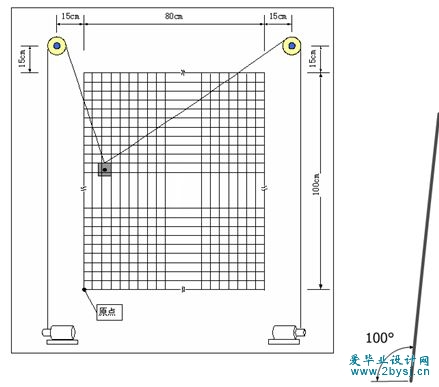
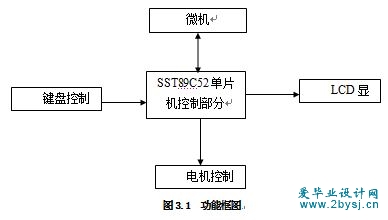
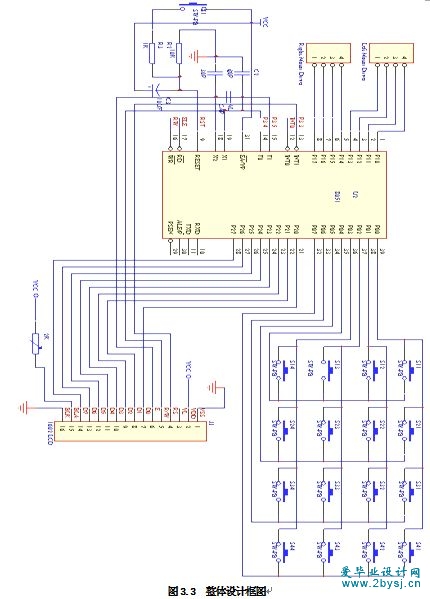

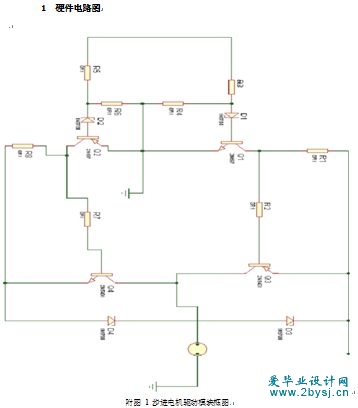
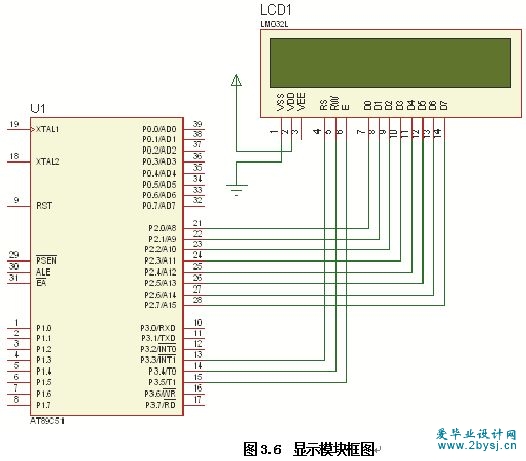
目 录
第1章 绪论 1
1.1 课题来源 1
1.2 课题目的 1
1.3 课题意义 2
1.4 应解决的主要问题 2
1.5 技术要求 2
第2章 方案论证 4
2.1 可行性研究 4
2.1.1 经济可行性研究 4
2.1.2 技术可行性研究 4
2.1.3 方案提出 5
2.1.4 方案分析 5
2.1.3 方案确定 7
2.2 需求分析 7
第3章 过程论述 8
3.1 概要设计 8
3.1.1 系统功能设计 8
3.1.2 系统结构设计 8
3.2 详细设计 9
3.2.1 硬件设计 9
3.2.2 软件设计 19
第4章 系统测试 28
4.1 硬件测试 28
4.2 软件测试 28
4.2.1 单元测试 28
4.2.2 集成测试 30
4.2.3 功能测试 31
4.2.4 测试结果 32
结 论 33
后 记 34
参考文献 35
附 录 36
